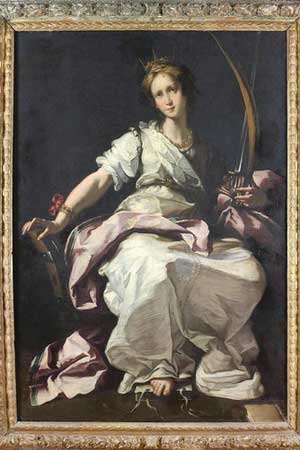News:
Italy denies U.S. export license to Baroque painting looted by Nazis
By Jori Finkel
Philippa Calnan's grandfather acquired 'St. Catherine of Alexandria' by Bernardo Strozzi a century ago. The Beverly Hills resident is fighting for its return.

"Saint Catherine of Alexandria " by Bernardo Strozzi. The Nazi-looted artwork is in storage in Milan. (Philippa Calnan)
The first time Philippa Calnan saw the Nazi-looted painting of St. Catherine of Alexandria by Bernardo Strozzi that had once belonged to her family was "an extremely moving moment." Now, the Beverly Hills art aficionado says her emotions are running high for another reason: The Italian courts recently denied her application for an export license that would allow her to bring the painting back to the U.S.
The Italian Baroque painting, dating from the early 17th century, measures roughly 5.6 by 4 feet. It features a troubled-looking Saint Catherine seated in a flowing robe besides a spiked wheel, a torture device so closely associated with her martyrdom that it's known as the Catherine Wheel.
"St. Catherine of Alexandria" was one of many masterpieces acquired by Calnan's grandfather, Charles A. Loeser, a century ago. A New Yorker by birth who studied art history at Harvard (where the legendary scholar Bernard Berenson was a classmate), Loeser spent most of his life in Florence, writing about art and building a first-rate collection. Upon his death in 1928, he bequeathed eight Cézanne paintings to the White House and a cache of 262 drawings, rich with Italian Masters, to the Fogg Museum at his alma mater.
He also donated more than 30 medieval and Renaissance works of art and furniture to the city of Florence, where they are housed at the Palazzo Vecchio. In exchange for his generosity, the government granted his family permission to export, free of charge, any remaining works from his collection up until two years after the death of his daughter, Matilda Loeser Calnan.
What they did not foresee is that a group of artworks from Loeser's Villa Torri Gattaia in Florence would later be stolen by the Nazis, after being seized in 1942 by the prefect of Florence under the anti-Jewish "racial laws" issued by the Italian fascist regime. Rodolfo Siviero, the Italian art historian (turned secret agent for the Allied Forces) who helped to lead Italy's post-World War II efforts at recovering Nazi-plundered artwork, included the Strozzi painting of Saint Catherine in a book of looted paintings.
Philippa Calnan, the Beverly Hills resident who says she is now Loeser's sole heir, says Sotheby's Milan office contacted her in 2009 to let her know that an individual had offered the painting, which they had identified as the looted Strozzi, for one of their upcoming auctions. It was a surprise to her. "I remember growing up hearing my mother and father talking about things that were missing, but I had never heard of this painting," she says. (Nor, she says, does she know the whereabouts of two other family paintings known to have been looted.)
Shortly after speaking to Sotheby's, she says she received a call from art-loss specialists with the Carabinieri, or Italian state police, inviting her to look at the painting in a back room at the auction house.
"When I first saw the painting, tears welled up in my eyes," says Calnan, who herself worked in the art world before retiring, most recently as the director of public affairs for the Getty Trust. "It's a big and very beautiful painting, and I almost felt presence of my grandfather coming down from above and saying: Now it's up to you."
She says she was given permission by the Carabinieri to remove the painting, by one estimate worth approximately $700,000. Within a matter of weeks, she placed it in storage in Milan in her name. "I thought I would then be able to export it to Los Angeles."
Instead, a regional court in Lombardy known as the Tribunali Amministrativi Regionali, or TAR for short, denied her application for an export permit on the grounds that the deadline had expired in 2004, two years after the death of her mother. The first denial took place last year; a second rejection, prompted by an appeal, took place earlier this month. (The director of cultural heritage in Lombardy was unavailable for comment.)
Calnan says she is "mystified" by the decision. "All I can imagine is that some little guy in the basement of TAR with a calculator, looking at the agreement between my grandfather and city of Florence completely out of context, figured out that there was a period where my mother could have sold that painting. They didn't look at the bigger picture — the fact that my grandfather left a very important collection to Florence and that we were 'enemy aliens' and had to escape from the Nazis."
They missed the key point, she says: "My mother did export a number of things, but it was not possible to export this work because it was stolen."
Her attorney Alessandro Pallottino calls the decision "wrong and unfair." Not only was the painting missing for decades, he says, but "no application for an export license can be submitted without, at the same time, submitting the painting itself."
Pallottino says he is preparing to appeal the decision with the Council of State, Italy's highest court. He also confirms that criminal proceedings are beginning against the unidentified individual who claimed ownership of the Strozzi painting and offered it for sale at Sotheby's.


